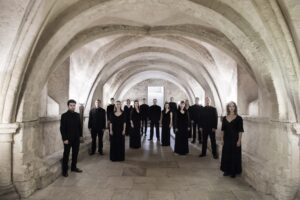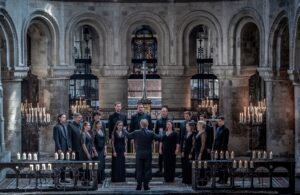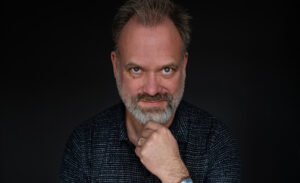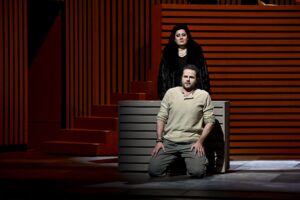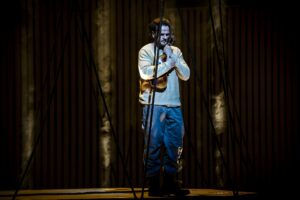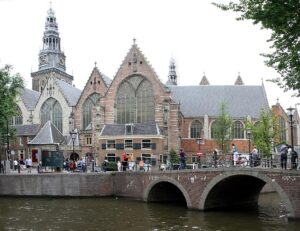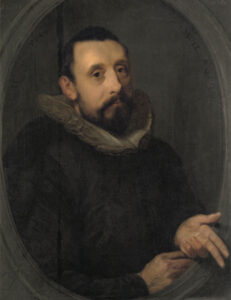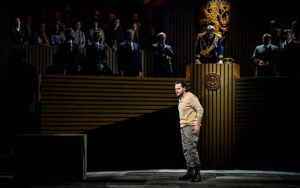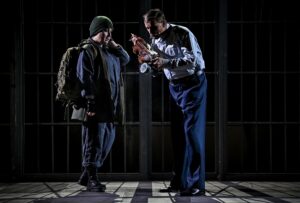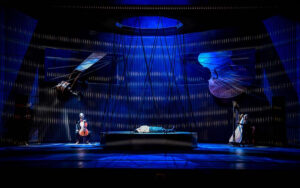And They Went to the End of the World
When it is time to sow millet in the mountains of northern Taiwan, the men of the indigenous Bunun ethnic group celebrate the Pasibutbut ritual. Dressed in festive garments, they line up in a circle, entwined by their arms, and then intone a song to the powerful deity dehanin. The singing begins in a very low register and gradually rises with a series of microtonal changes happening synchronously in all the voices. In fact, there are no more than five voices, but owing to the heterophonic texture, and the harmonics of various timbres and pitches, the song gives the impression of being a highly complex polyphonic piece. The singing is said to have been inspired by the buzzing of bees, the swoosh of waterfalls and the rustling of bamboo leaves. Pasi means community, butbut – mutual support. The ritual lasts a few minutes, and the degree of harmony between the singers is regarded as a signal of whether the harvest will be good.
When the first sounds of Joby Talbot’s Path of Miracles rang out in King’s College Chapel in Cambridge – in an excerpt reminiscent of the Pasibutbut ritual, but with a more condensed and rising crescendo until a powerful clash with the anthem Dum Pater Familias – I immediately thought that the degree of understanding among the members of the Tenebrae choir augured a remarkably bountiful harvest. The hour-long piece, a musical record of a pilgrimage to Santiago da Compostela along the Camino Francés, the busiest of the Ways of St. James, was commissioned especially for Tenebrae and premiered in 2005, at London’s St. Bartholomew-the-Great Church. It has since travelled halfway across the world with the ensemble. In 2006 it was heard in Spanish churches along the French Way, a decade later it was included in the main programme of the choir’s 15th anniversary celebrations, and this year it came to Cambridge the day after a concert at St. Martin-in-the-Fields, only to end up at Hamburg’s Elbphilharmonie two days later, on 29 March. Tenebrae is planning at least three more performances of Path of Miracles before the end of the year, also in Switzerland.
Tenebrae. Photo: Sim Canetty-Clarke
When he accepted the commission, Talbot had barely turned thirty, but he already had some notable compositional successes under his belt – and in surprisingly diverse fields at that, from quite “serious” commissions, including for the BBC Philharmonic, to music for TV series, and collaborations with pop and rock bands. The work on Path of Miracles lasted over three years and from the beginning it was marked by a genuine admiration for Tenebrae’s musical craftsmanship. There is indeed much to admire, as this is a truly remarkable ensemble. It was founded by the countertenor Nigel Short, a longtime member of The King’s Singers and The Tallis Scholars, an oratorio and opera soloist as well as a composer, who dreamed of a choir that would combine the panache and drama of performance with precision worthy of the best chamber ensembles. Singers of the stature of Emma Walshe, Guy Cutting and Matthew Brook have all passed through his Tenebrae. The 19-strong line-up in the Cambridge performance of Path of Miracles included two members of the illustrious Gesualdo Six group – its founder Owain Park and Joseph Wicks.
Talbot has taken full advantage of Tenebrae’s potential, writing the score for seventeen vocal parts and dividing the material into four movements – choral images of four stopovers along the pilgrimage route, from Roncesvalles, the first stopover on the Camino Francés after crossing the Pyrenees, through Burgos and León to Santiago. The different movements are sharply contrasted. The trance-like beginning and the euphoria that accompanies the start of the journey are followed by a period of battling with dark forces in Burgos; the battle gets forgotten in the light-bathed León cathedral. The fourth movement begins with an arduous climb to the top of Monte de Gozo – Mountain of Joy – where the euphoria returns at the sight of the towers of the Santiago cathedral. However, this is not the end of the way, which, after the spiritual rapture and unbridled revelry in the city of St. James, leads the pilgrims to the end of the world, or Finisterre, where they can finally take a dip in the ocean, wash off the dirt and start everything all over again.
Joby Talbot. Photo: Anna McCarthy
The composer has confused the pilgrims’ tongues. Texts taken from liturgical and medieval sources (in Latin, Greek, French, German, Basque and Spanish) are cemented by English poems by Robert Dickinson, responsible for the entire libretto. Musically, Path of Miracles is a masterpiece of noble eclecticism. Talbot successfully appeals to the sensibilities of every listener. If he verges on kitsch anywhere, it is only in the León section, where he has succumbed to the temptation to paint a mood of bliss with oversimplified harmonic means. Elsewhere, however, he impresses with his technical mastery: he brilliantly juxtaposes textures, contrasts sounds in extreme registers, and plays with the movement of sound in space. He colours the melody with modalisms, shifts tonal centres with a grace worthy of the French impressionists, and stops chords by means of methods known from Tavener’s best works. Talbot has created a thing of unpretentious beauty, marked by a clear spiritual experience, accessible and understandable even to a diehard agnostic.
I find it difficult to imagine more sensitive and competent performers of this composition than the Tenebrae choir, in which each singer speaks in their own distinct voice, or blends into a perfectly coherent whole with the rest of the ensemble. And in doing so, they do not need to use a tuning fork, which has become an indispensable tool for most contemporary choristers. An hour of music flowing freely, without heads being tapped with a pitchfork, without the narrative being stopped in order for the right note to be given by the conductor. A performance that I listened to with delight, disbelief and regret that I would not experience such an emphatic sense of community and mutual support any time soon. We all need them like sunshine and water – not just for millet to grow.
Translated by: Anna Kijak

